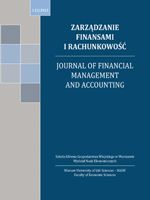Main Article Content
Article Details
BARAN J. 2007: Efektywność spółdzielni i pozostałych form prawnych działających w przemyśle mleczarskim z wykorzystaniem metody DEA, Roczniki Nauk Rolniczych, Seria G, 94, 1, s. 109-116. (Crossref)
DOMAŃSKA T. 2014: Wielkość funduszu udziałowego a pozycja kredytowa spółdzielni mleczarskich, Zeszyty Naukowe Uniwersytetu Szczecińskiego nr 804, "Finanse, Rynki Finansowe, Ubezpieczenia" nr 67, Wydawnictwo Naukowe Uniwersytetu Szczecińskiego, Szczecin, s. 13-22.
DOMAŃSKA T. 2015: Kształtowanie efektywności finansowej a wielkość spółdzielni mleczarskich, Studia i Materiały. Miscellanea Oeconomicae, Kielce, 19, 3, s. 35-42.
DWORNIAK J. 2010: Ekonomiczno-finansowe skutki zmian funduszu udziałowego w spółdzielniach mleczarskich, Wydawnictwo SGGW, Warszawa.
GRABOWSKA M. 2012: Zarządzanie płynnością finansową przedsiębiorstw. CeDeWu, Warszawa.
KRZEMIŃSKA D. 2005: Finanse przedsiębiorstwa, Wydawnictwo Wyższej Szkoły Bankowej, Poznań.
KRZEMIŃSKA D. 2009: Wiarygodność kontrahenta w kredycie kupieckim, Wydawnictwo Uniwersytetu Ekonomicznego w Poznaniu, Poznań.
RYTKO P. 2009: Zarządzanie kredytem handlowym w małych i średnich przedsiębiorstwach, Difin, Warszawa.
USTAWA z dnia 16 września 1982r. Prawo Spółdzielcze, Dz.U., nr 30, poz. 210, z póź. zm.
USTAWA z dnia 29 września 1994 r. o rachunkowości, Dz.U. 1994 nr 121, poz. 591, z póź. zm., Wydawnictwo LEGIS, Warszawa 2012.
WĘDZKI D. 2000: Teoria zintegrowanego zarządzania kredytem handlowym w przedsiębiorstwie, Wydawnictwo Akademii Ekonomicznej w Krakowie, Kraków.
ZAWADZKA D. 2009: Determinanty popytu małych przedsiębiorstw na kredyt handlowy, Identyfikacja i ocena, Wydawnictwo Uniwersytetu Ekonomicznego w Poznaniu, Poznań.
Downloads
- Teresa Domańska, Tomasz Felczak, The differentiation of financial situation in dairy cooperatives in Poland , Zarządzanie Finansami i Rachunkowość : Vol. 5 No. 4 (2017)
- Teresa Domańska, Determinants of financial liquidity in the dairy cooperatives , Zarządzanie Finansami i Rachunkowość : Vol. 4 No. 4 (2016)
- Teresa Domańska, Tomasz Felczak, The structure and level of debt and the efficiency of individual farms, depending on the size of the economic , Zarządzanie Finansami i Rachunkowość : Vol. 2 No. 3 (2014)




